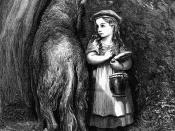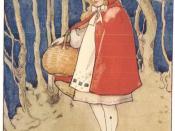Different versions of ÃÂLittle Red Riding HoodÃÂ have been retold throughout written history. Each retelling was written in a culture of its own, which holds its own philosophies on each of the continuing main ideas in each version. One integral philosophy is their principles of femininity. Because so much time had past from the original work to the time of the newer retelling, the newer version had to be rewritten to tell a different tale, distinguishing the principles of femininity that the two cultures contrasted. Two versions that contrast very well are Brother GrimmÃÂs ÃÂLittle Red CapÃÂ and Tanith LeeÃÂs ÃÂWolflandÃÂ. They offer different positions of femininity, one representing the innocence of the earlier 19th century, the other representing the dominance of the late 20th century.
In GrimmÃÂs traditional version, the femininity of Little Red Cap and her grandmother is a rather fragile one. Little Red Cap is an innocent character.
She sees no danger in giving detailed information about the location of her grandmotherÃÂs house, her destination, to a complete stranger: ÃÂHer house is right under three large oaks. You must know the place from the hazel hedges near ità(Grimm 620). She is also a naïve character, following the advice of the wolf to gaze upon the flowers and birds in the woods, without ever thinking about his intentions, as she should not have listened to anyone: ÃÂLittle Red Cap, have you seen the beautiful flowers all about? Why donÃÂt you look around for a while? I donÃÂt think youÃÂve even noticed how sweetly the birds are singingà(Grimm 621). Little Red Cap and her grandmother are submissive to masculinity. In this particular version, the grandmother is eaten by the wolf, and later Little Red Cap. Furthermore, both women in this story are rescued by...


